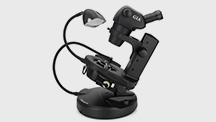How GIA Identifies and Classifies Pearls
Although GIA is most recognized as the world’s foremost authority in diamond grading, it has been a leader in the identification and classification of natural and cultured pearls since 1949.
GIA has contributed to the revision of the FTC’s pearl guidelines for the jewelry industry and is responsible for working with major pearl companies globally to develop comprehensive standards for describing pearls. These standards are the GIA 7 Pearl Value Factors™: Size, Shape, Color, Nacre, Luster, Surface, and Matching.
Inspection, Care, and Handling Procedures
GIA applies the same item identification and tracking procedures to all pearls, as it does for colored stones and diamonds. Each item is assigned a bar-coded label with a unique internal identification number that is used to track it throughout the process. And at every step, special inspection, care, and handling procedures ensure items are managed with the utmost care.
Weights and Measures
This is the first stop for any item submitted for pearl services. Pearls are counted by hand and then weighed with an electronic micro-balance that captures the weight in grams (mounted or strung), carats (loose), or carats and grains (loose natural). Pearls are measured using special digital calipers.
Identification and Classification
Items are then transferred to the Identification Inventory Control department for distribution to trained and experienced gemologists for servicing. Once an item is received by an initial gemologist, its recorded weight and measurements are verified. The gemologist identifies pearl types, mollusks and any detectable treatments using the standard gemological testing and advanced testing equipment, including real-time X-radiography, UV-Vis reflectance spectroscopy and XRF. Real-time microradiography equipment is used to measure the nacre thickness of bead-cultured pearls if the nacre appears thin or when requested by the client. Loose pearls requiring more detailed analysis may be analyzed using computed micro-tomography (μCT).
The gemologist determines color and classifies the other factors under a controlled viewing and lighting environment, using a comprehensive set of pearl masters. The pearl master sets include a hue circle and various color grids to determine color, and type-specific master sets of strands to classify luster, surface and matching.
After that, the item is transferred to a second gemologist, who independently performs all necessary observations and testing. Depending on the identity and nature, the item may be examined by additional gemologists and research specialists.
Report Processing and Item Return
Reports are generated after all results are finalized and services have been completed. All GIA Reports are examined and proofread to ensure quality before being sent to the client.
Last, the item is placed in its original container, joined with its report, and goes through final inspection and testing to ensure that the same submitted item is returned to the client.
Items are returned either in person through the Client Services department, or via courier through the Transport Services department. All information recorded for an item remains stored in GIA’s permanent database for future reference.



